Fly is an insect with one pair of well-developed wings. The common house fly is one of the best-known kinds of flies. Other kinds include black flies, blow flies, bot flies, crane flies, deer flies, fruit flies, gnats, horse flies, leaf miners, midges, mosquitoes, robber flies, sand flies, tsetse flies, and warble flies.
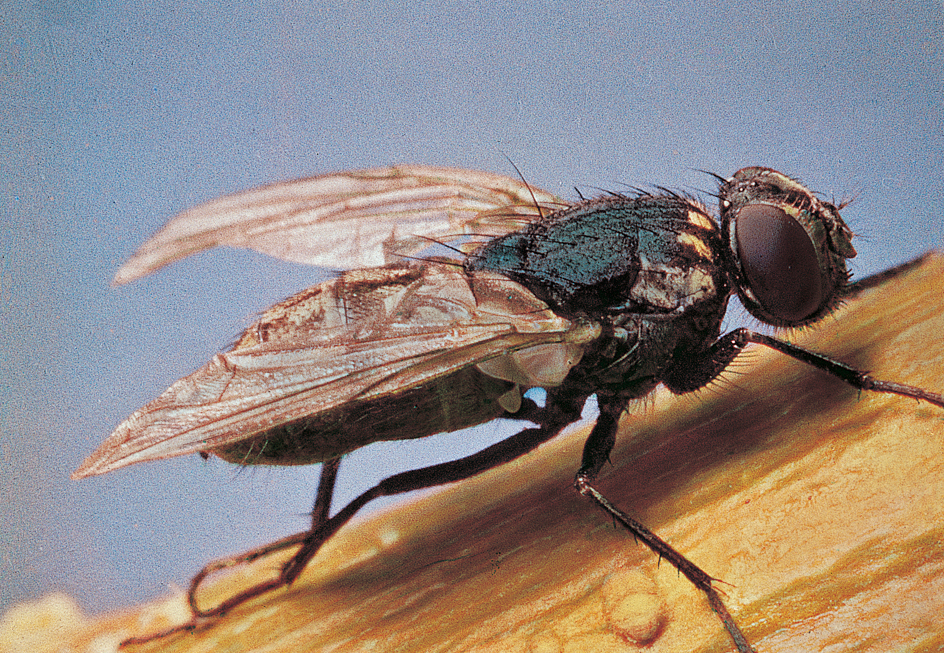
A number of other insects are often called flies, but they have four wings and are not true flies. These insects include butterflies, caddisflies, damselflies, dragonflies, mayflies, and scorpionflies.
Flies live throughout most of the world. Among the smallest are the midges called no-see-ums, which inhabit forests and coastal marshes. They measure about 1/20 inch (1.3 millimeters) long. One of the largest flies, a kind of mydas fly, occurs in South America. It grows 3 inches (7.6 centimeters) long and also measures 3 inches from the tip of one wing to the tip of the other.
Flies are among the fastest of all flying insects. The buzzing of a fly is the sound of its wings beating. A house fly’s wings beat about 200 times a second, and some midges move their wings 1,000 times a second. House flies fly at an average speed of 41/2 miles (7.2 kilometers) per hour. They can fly even faster for short distances to escape enemies, which include people and many birds.
Some flies are among the most dangerous pests known. They carry germs inside their bodies, on the tip of their mouthparts, or in the hair on their bodies. When a fly “bites,” or when it touches any object, it may leave some of these germs behind. Flies carry germs that cause serious diseases in people and other animals. Such diseases include malaria, sleeping sickness, and dysentery. Flies also cause diseases that affect plants.
People have developed many ways to control flies in places where the insects can become too abundant. Some swamps are drained or covered with oil. People also spray chemical insecticides in swamps and rivers to kill newly hatched flies. Other helpful control practices include the proper disposal of garbage, decaying plants, and animal wastes.
Flies also can prove helpful to people and the environment. Some types carry pollen from one plant to another, much as bees do. Others eat insect pests. Scientists use fruit flies in the study of heredity. These flies have provided valuable information on how traits are passed on from one generation to the next.
There are thousands of species (kinds) of flies. They make up an order (chief group) of insects. The scientific name of the order is Diptera, which comes from Greek words that mean two wings. This article provides general information about flies. To learn more about various kinds of flies, see the separate World Book articles listed in the Related Articles at the end of this article.
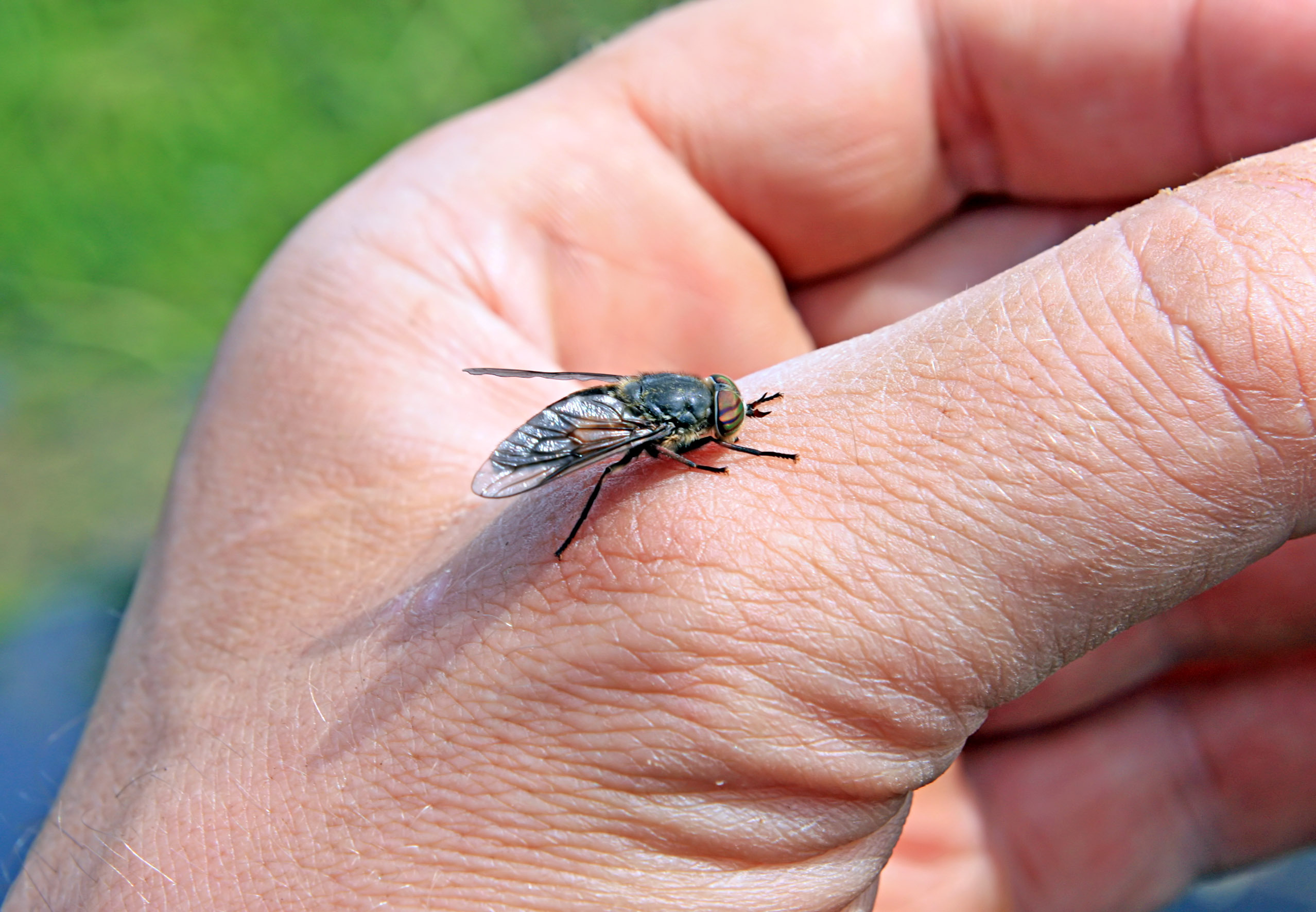
The body of a fly
A fly’s body has three main parts: (1) the head, (2) the thorax, and (3) the abdomen. The body wall consists of three layers and is covered with fine hair. Many kinds of flies have dull black, brown, gray, or yellowish bodies. A few kinds, including soldier flies and hover flies, may have bright orange, white, or yellow markings. Some kinds, such as bluebottle flies and greenbottle flies, are shiny blue or green. They seem to sparkle with brassy, coppery, or golden lights.
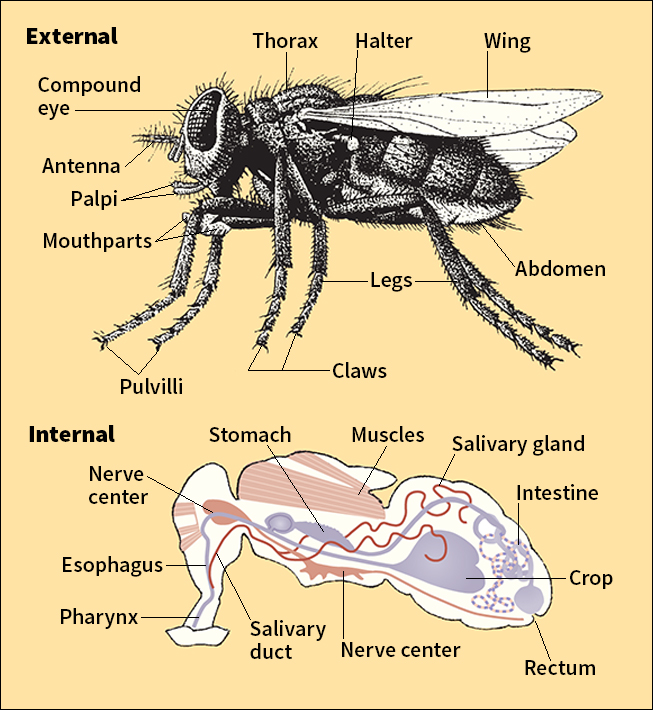
Head.
A fly has two large eyes that cover most of its head. The males of some species have eyes so large that they squeeze against each other. The eyes of most female flies are farther apart.
Like most other kinds of insects, a fly has compound eyes made up of thousands of six-sided lenses. A house fly has about 4,000 lenses in each eye. No two lenses point in exactly the same direction, and each lens works independently. Everything a fly sees seems to be broken up into small bits. The insect does not have sharp vision, but it can quickly see any movement.
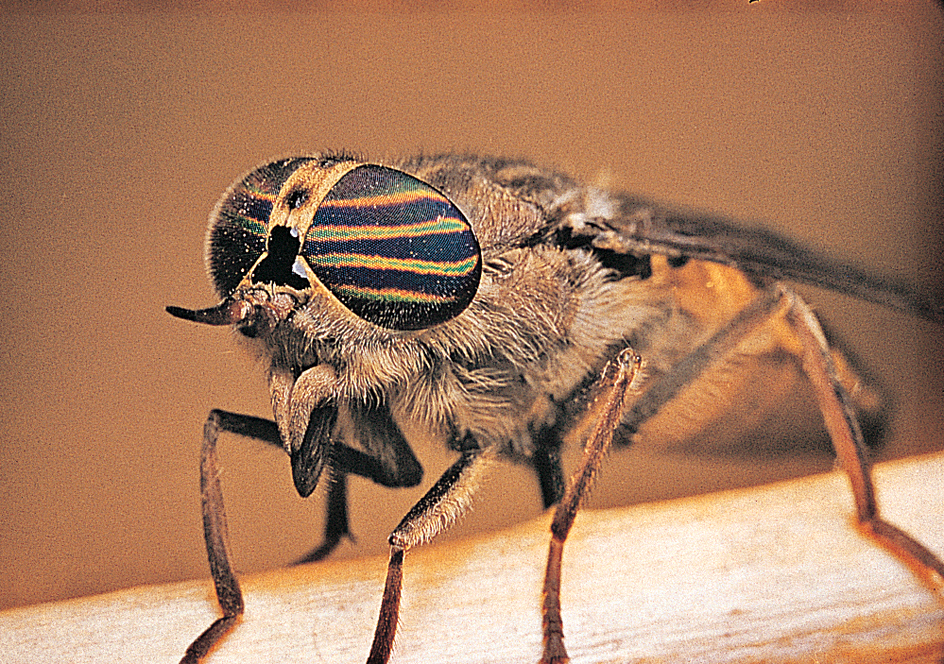
A fly has two antennae that warn it of danger and help it find food. The antennae grow near the center of the head between the eyes. The size and shape of the antennae vary widely among different species of flies, and even between males and females of the same species. A house fly’s antennae are short and thick; a female mosquito’s are long and covered with hair; and a male mosquito’s are long and feathery. The antennae can feel changes in the movement of the air, which may warn of an approaching enemy. Flies also smell with their antennae. The odor of the chemicals in rotting meat and garbage attracts house flies. The odors of certain chemicals bring vinegar flies to wine cellars.
The mouth of a fly looks somewhat like a funnel. The broadest part is nearest the head, and tubelike part called the proboscis extends downward. A fly uses its proboscis as a straw to sip liquids, its only food.
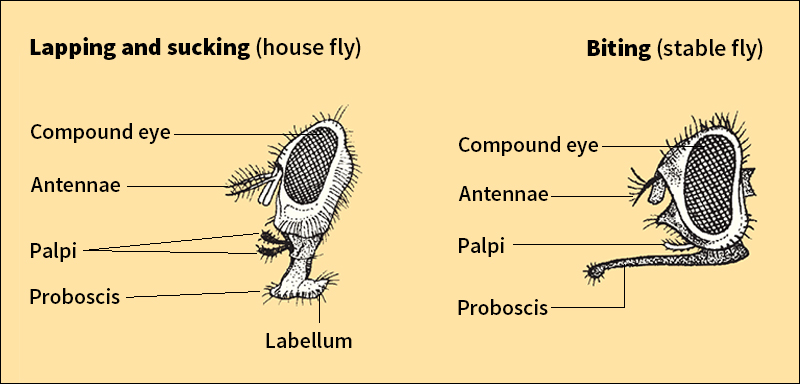
Flies do not bite or chew because they cannot open their jaws. Mosquitoes, sand flies, stable flies, and other kinds of “biting” flies have sharp mouthparts hidden in the proboscis. They stab these sharp points into a victim’s skin and inject saliva to keep the blood from clotting. Then the flies sip the blood. Blow flies, fruit flies, and house flies do not have piercing mouthparts. Instead, they have two soft, oval-shaped parts called labella at the tip of the proboscis. The flies use these parts somewhat like sponges to lap up liquids, which they then suck into the proboscis. They sip liquids, or turn solid foods such as sugar or starch into liquids by dropping saliva on them.
Thorax.
A fly’s muscles are attached to the inside wall of the thorax. These strong muscles move the insect’s legs and wings. A fly has six legs. It uses all its legs when it walks but often stands on only four legs. The legs of most kinds of flies end in claws that help them cling to such flat surfaces as walls or ceilings. House flies and certain other flies also have hairy, sticky pads called pulvilli on their feet. These pads help the insects walk on the smooth, slippery surfaces of windows and mirrors.
A fly’s wings are so thin that the veins show through. The veins not only carry blood to the wings, but they also help stiffen and support the wings. Instead of hind wings, a fly has a pair of thick, rodlike parts with knobs at the tips. These parts are called halteres. The halteres give the fly its sense of balance. Halteres vibrate at the same rate as the wings beat when the insect is flying.
Flies on a flower
A fly is airborne as soon as it beats its wings. It does not have to run or jump to take off. In the air, the halteres keep the insect in balance and guide it so it can dart quickly and easily in any direction. A fly does not glide in the air or to a landing as do butterflies, moths, and most other flying insects. A fly beats its wings until its feet touch something to land on. If you pick up a fly, but leave the legs and wings free, the wings begin to beat immediately. Scientists sometimes do this with flies when studying wing movements.
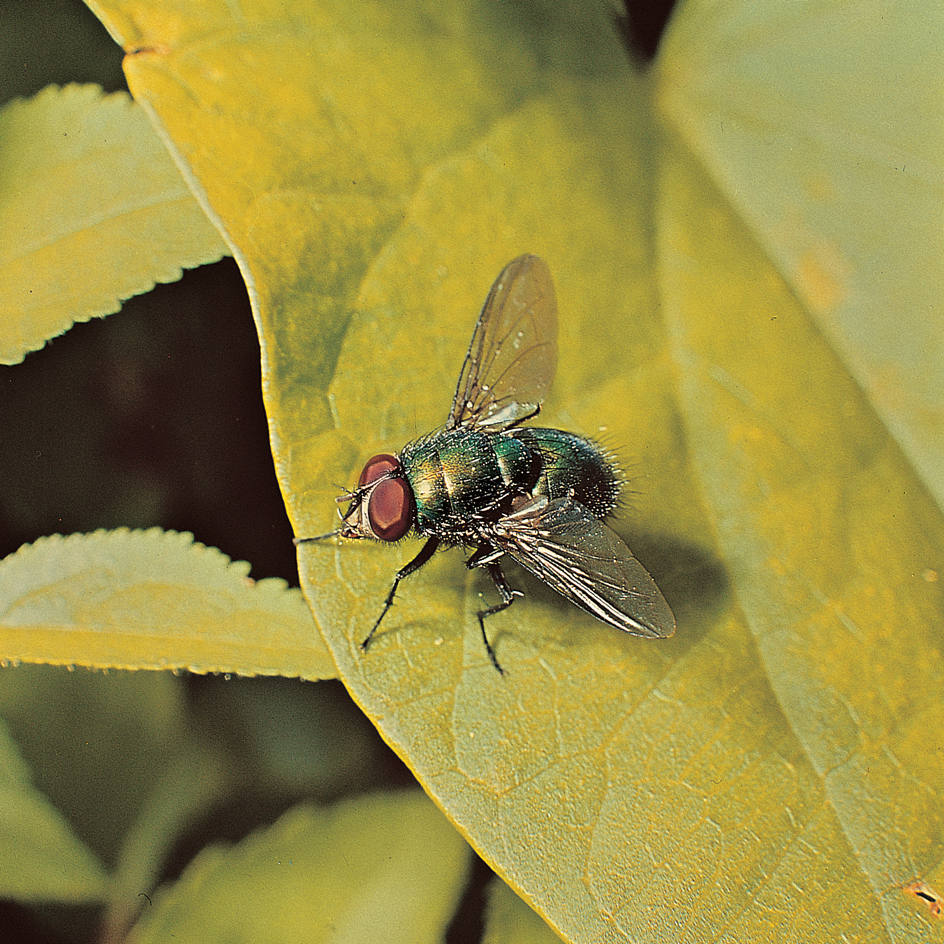
Abdomen.
A fly breathes through air holes called spiracles along the sides of its body. The abdomen has eight pairs of spiracles, and the thorax has two pairs. Air flows through the holes into tubes that carry it to all parts of the fly’s body.
The life of a fly
A fly’s life is divided into four stages: (1) egg, (2) larva, (3) pupa, and (4) adult. At each stage, the fly’s appearance changes completely.
Egg.
A female fly lays from 1 to about 250 eggs at a time, depending on the species. During her lifetime, one female may produce as many as a thousand eggs. The females of many species simply drop their eggs on water, on the ground, or on other animals. Some species stack the eggs in neat bundles.
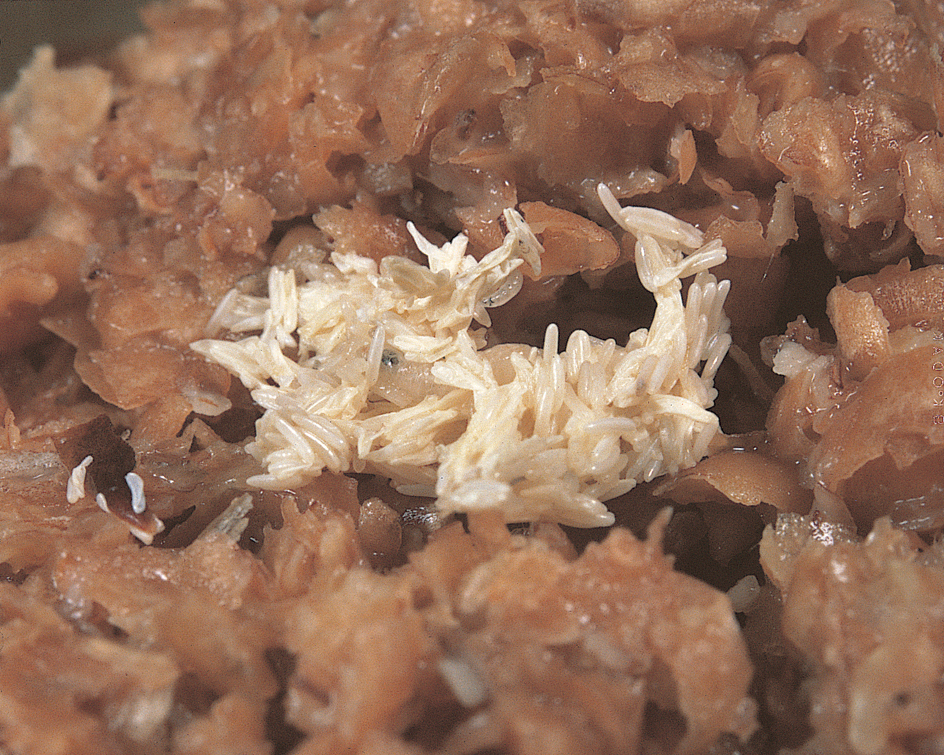
At the tip of a female fly’s abdomen is an organ called the ovipositor, through which the eggs are laid. The house fly usually places her ovipositor onto soft masses of decaying plant or animal material and lays her eggs there. One kind of mosquito arranges its eggs in groups that look somewhat like rafts. The eggs float on water until the larvae hatch.
The eggs of many kinds of flies are white or pale yellow, and they resemble grains of rice. A house fly’s eggs hatch in 8 to 30 hours, but the time depends on the species of fly. Some mosquitoes lay their eggs during late autumn. But the eggs do not hatch until spring.
Larva.
People refer to most fly larvae as maggots. Mosquito larvae are called wrigglers because of the way they move in water. The larvae of most kinds of flies look like worms or small caterpillars. They often live in food, garbage, sewage, soil, water, and in living or dead plants and animals. A tsetse fly larva grows inside its mother’s body and receives nourishment from her.

Fly larvae spend all their time eating and growing. They molt (shed their skin and grow a new one) several times as they grow. The larval stage lasts from a few days to two years, depending on the species. The larvae then change into pupae.
Pupa
is the stage of final growth before a fly becomes an adult. The pupae of mosquitoes and some other kinds of flies that develop in water are active swimmers. Most pupae that live on land remain quiet. The larvae of some flies build a strong oval-shaped case called a puparium around their bodies. Black fly larvae spin a cocoon for protection. Inside, the larva gradually loses its wormlike look and takes on the shape of the adult fly. Then the adult fly bursts one end of the pupal case or splits the pupal skin down the back and crawls out. The pupal stage of a house fly lasts from three to six days in hot weather, and longer in cool weather. The length of time varies among the different species.
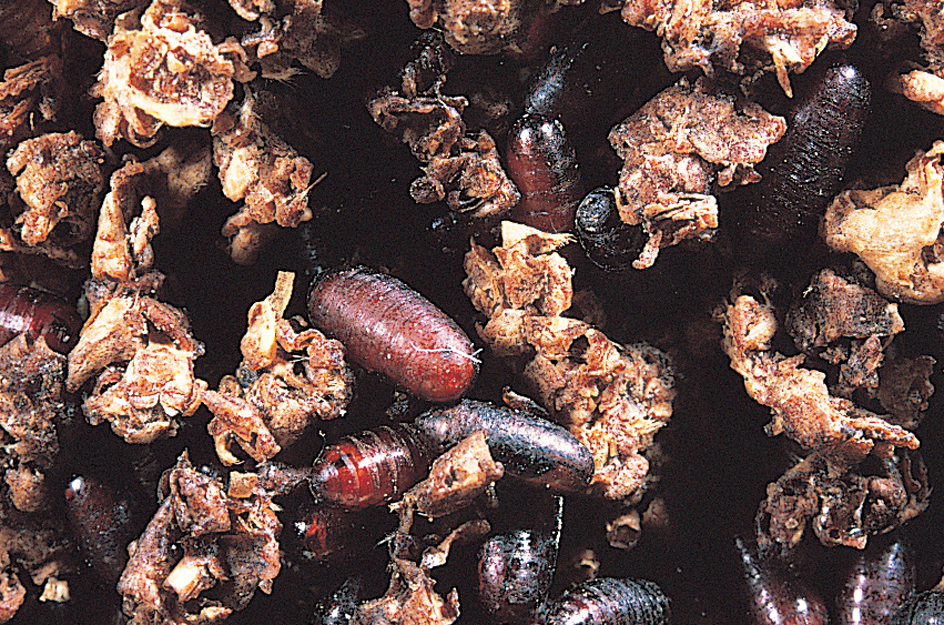
Adult.
When the adult emerges from the pupal case, its wings are still moist and soft. The air dries the wings quickly, and blood flows into the wing veins and stiffens them. The thin wing tissue hardens in a few hours or a few days, depending on the species, and the adult flies away to find a mate.
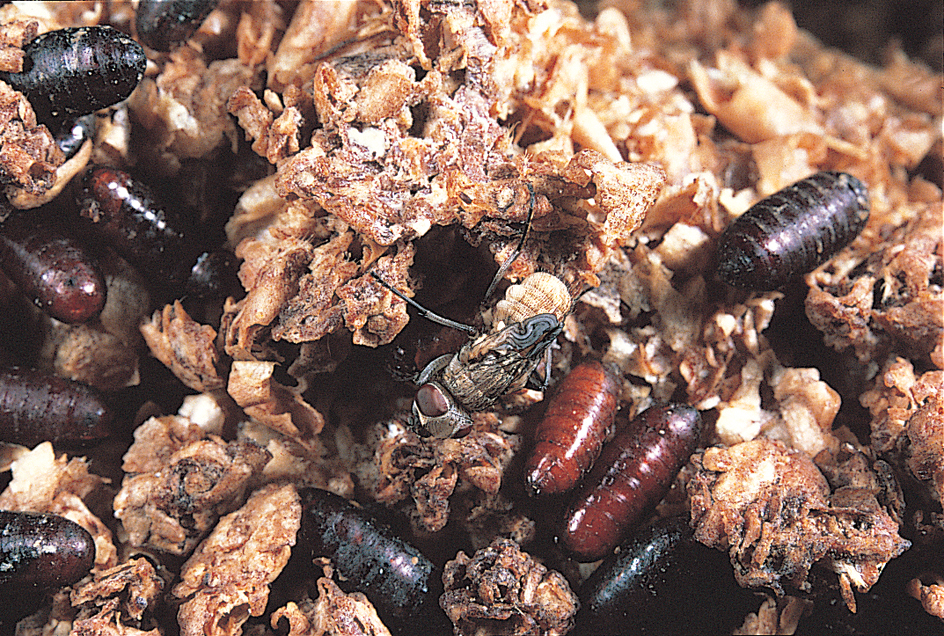
A fly has reached full size when it comes out of the pupal case. A small fly grows no larger as it gets older, even though its abdomen may swell with food or eggs.
Adult house flies live about 21 days in summer. They survive longer in cool weather but are less active. Most adult flies die when the weather gets cold, but some hibernate. Many larvae and pupae stay alive during the winter. They develop into adults in spring.
